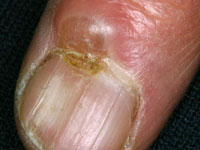Posts Tagged ‘warts’
Myxiod Cyst or Digital Mucous
Myxiod Cyst or Digital Mucous
 A Myoxid cyst develops because of alterations in the tissue on the tip of the toe. A cyst is a shiny, smooth bump. It is soft and rubbery and looks sort of transparent. When they develop, it is usually towards the end of fingers or toes. Usually they are about 1/5-3/5 inch wide and form in a circular or ovoid shape. Digital Mucous occurs when these cysts burst and emit a thick fluid, whitish or yellowish in color. These cysts occur more commonly in women and in people 45 years or older.
A Myoxid cyst develops because of alterations in the tissue on the tip of the toe. A cyst is a shiny, smooth bump. It is soft and rubbery and looks sort of transparent. When they develop, it is usually towards the end of fingers or toes. Usually they are about 1/5-3/5 inch wide and form in a circular or ovoid shape. Digital Mucous occurs when these cysts burst and emit a thick fluid, whitish or yellowish in color. These cysts occur more commonly in women and in people 45 years or older.
What Causes This?
Myxoid cysts usually develop where a recent minor trauma or an old injury have occurred. Friction (similar to a blister) is also a culprit. Submerging your hands in water for a long time can make these cysts occur as your body soaks up the liquid and it collects as a bump, potentially developing a bit of an infection.
How Do I Treat It?
The nice thing about this particular disease is that there is no urgency in seeking treatment until it becomes painful or begins to throb. Sometimes this disease is self- curing and it just goes away, it can also be eliminated by pressing on or squeezing the cyst. Medically, the popular way to remove these cysts is cryotherapy or freezing.
- Cryotherapy is the process of freezing an area of skin to kill off infection. The most commonly used freezing chemicals are liquid nitrogen, carbon dioxde snow, propane, and Dymethy ether. Of these, liquid nitrogen us most used. This has become a very safe, fast and effective way of removing many kinds of unwanted cysts and warts.
- Liquid Nitrogen (NO2) Treatment – A cryoprobe, cryospray or coated cotton tipped applicator is applied to the affected area. This freezes the cyst and allows the skin to heal.
- CO2 Snow Treatment – Carbon Dioxide Cryotherapy uses a tube of icy carbon dioxide flurry, sprayed directly onto the affected skin
- DMEP treatment – Using a foam applicator, the chemical is applied directly to the affected area for between 20 and 50 seconds, depending on the size and place on the body.
Myxoid cysts can be removed surgically but this increases the possibility that they will reoccur. If you choose this method, your doctor will examine the cyst with an ultra-sound or x-ray. It is also likely that an MRI will be scheduled.
If the cyst is not particularly painful, your doctor can insert a needle into the cyst and withdraw the fluid that way, leaving the skin to heal.